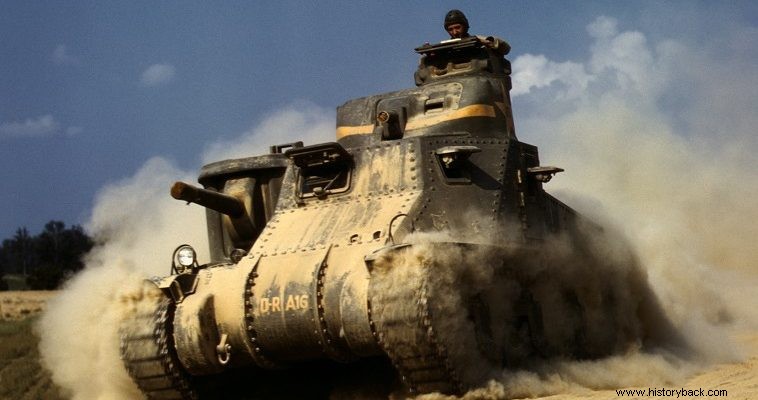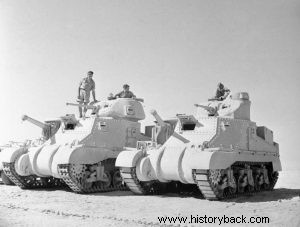
The M3 tank, known as Grant or Lee, after the names of the famous generals of the American Civil War, was the first battle-worthy medium tank of the American army. However the M3 first fought under the British flag in the hot African desert.
The M3 was an American copy of the French Char B1 bis. Carried a 75mm M2/3 gun. on the starboard side of the ship, which also placed explosive shells and a 37 mm gun. in the tower. Also carried 2 – 4 0.30in machine guns. It had a weight of 27 tons, maximum armor thickness of 51 mm. and a crew of 6 (Grant) or 7 (Lee) men.
It developed a maximum speed on the road of the order of 42 km per hour and had a range of approximately 190 km. Its main disadvantage was its great height (3.12 m.) which made it a visible target. Also as it had the main gun on board it could not be positioned in hull cover. A total of 6,258 tanks of the type were manufactured.
Success in North Africa
The chariot moved for the first time attached to the armored brigades of the British 8th Army at the Battle of Gazala on 27 May 1942. They were an extremely unpleasant surprise for the German and Italian tanks which until then faced the British tanks armed with the 2-pounder light cannon.
The Germans found that the M3 could with its 75 mm gun. to easily deal with even those armed with a 50mm cannon. Pz III, but also to destroy German anti-tank guns of the same caliber from distances that they could not answer.
And the Italian tanks had absolutely no luck. “Until May 1942 our tanks were generally superior to the corresponding British types. This is no longer the case, at least to the same extent," wrote the future field marshal Rommel. But the main opponent of the M3 proved to be the deadly German 88 mm cannon.
Tanks were first used in combat by the Americans during Operation Torch , that is, of the landing in the then French North African territories controlled by the Vichy government. In North Africa the M3 performed well. But it was soon replaced by the M4 Sherman and was not used as a tank in the European theater of war. With the exception of those given to the Soviet Union.
On the frozen steppe
At the beginning of 1941, the Americans had about 1,400 tanks of this type in the USSR. Of these, around 980 reached their destination (the others were lost along with the ships that carried them). The "Soviet" M3s were Lee, with American turrets that is. Nevertheless, the Soviets named them Grant (they had British-style turrets). The Soviets, however, did not particularly appreciate them because of their gasoline engine and began to have them in auxiliary roles from 1943 onwards. But they fought against the Germans and the Finns in the northern part of the Eastern Front, while they were also used in the famous battle of Kursk.
In the Pacific theater
In the Pacific theater the use of armored vehicles was limited. Also, the Japanese did not have particularly noteworthy tanks. There the M3s could easily overcome the Japanese tanks and adequately support the infantry which was also their main role now. The M3s operated less with the American forces and more with the British and Australian forces.
They were used by the Americans in the battles in the Marshall and Gilbert Islands in 1943 and on Mackin Island, where the 139th Division supported the 27th Infantry Division, in the same year. On the contrary, the British used them extensively against the Japanese in Burma. They also performed extremely well in the famous 14th Army of General Slim. In the battle of Ibal, the British M3s victoriously faced the Japanese 14th Tank Regiment, helping them to the utmost in repelling the Japanese attack.

Tank M3 Grant (left) and M3 Lee (right). The different tower can be seen.
